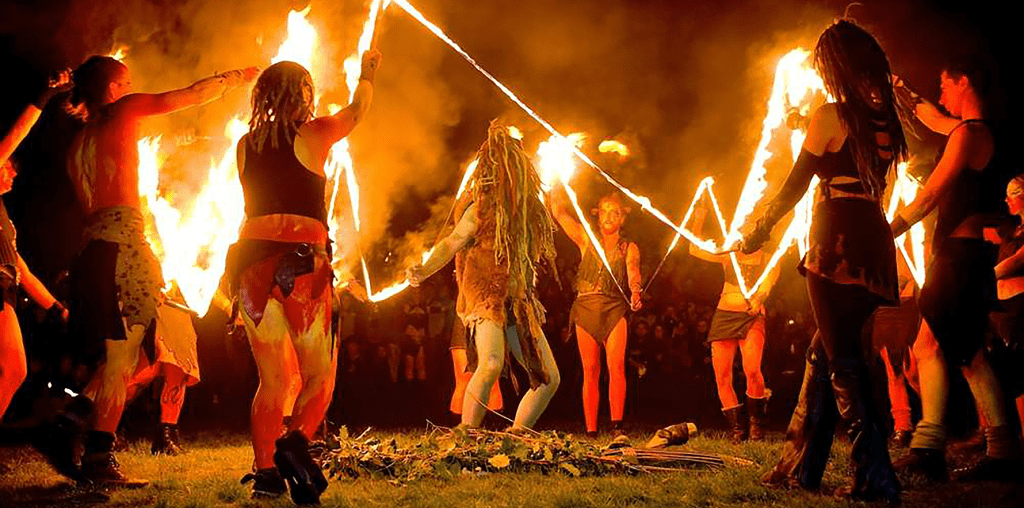Samhain (pronounced sah-when or sow-ween) is a Gaelic word meaning “summer’s end” or “summer into winter.” Samhain is celebrated on October 31 and November 1 with festivals, bonfires, and traveling feasts (going from house to house). Samhain is the start of the Celtic (kel-tick) New Year, and is considered a festival of the dead, as spirits of the deceased return to mingle with the living.
Celtic Paganism, Mythology, and Practices
Below are some beliefs and concepts associated with the celebration of Samhain
Harvest Celebration: Bonfires are held to celebrate the last harvest, burn off decay, and cleanse the land of harmful spirits.
Otherworld – Doorways to the Otherworld called sídhe (fairy mounds) open and allow the mischievous nature spirits to more easily come into the mortal world and wreak havoc during Samhain. More terms for the Otherworld include the Fae realm, spirit world, ghostly plain, realm of the dead.
Thinning of the Veil – The barrier between the realm of the dead and the mortal world becomes so thin that ghosts and souls of those who had died were able return to visit friends and family. Dressing up as a deceased love one was a way to pay respect to their memory, and accept gifts or offerings in their honor.
Offerings – People place offerings of food and drink outside their homes to the fairies in hopes the spirits would eat their fill and pass on to the next. Disguising yourself as a spirit, fairy, or demon is a way protect against the Fae when walking outside the home.
Change – As the seasons turn, summer gives way to winter and things begin to dry, mature, and die. Thus, Samhain is also a time to digest heavy emotions – grief, anger, sadness, worry, etc. – and allow those feelings to process and pass.
All Souls’ Day – As Catholic beliefs mixed with Irish and Scottish folk practices, Christian imagery was included in Samhain and syncretized with All Souls’ Day/All Hallows’ Eve (Halloween). This tradition lends itself fairly well to Samhain as both honor and pray for loved ones who have passed on.
Deities – The Mórrígan (Great Queen) and The Dagda (Great God), divine beings of earth and abundance, rule over Samhain and the Celtic New Year. The Mórrígan is the Celtic goddess of war, fate, and death; the Dagda is the god of agriculture, fertility, and life and death.
Surviving Practices
Some Samhain and All Hallows’ Eve traditions were kept alive by Irish and Scottish immigrants through the diaspora.
Apple Bobbing (dooking) – Apples were considered the food of the fairies and used in divination (fortune telling) rituals and games. Young people would bob for apples, peel the skin and toss it over their shoulder; the shape it made would be first letter of the name of their future spouse.
Mumming and Guising (“Trick-or-Treating”) – People would go from house to house in costume, singing and reciting rhymes in exchange for food. If the homeowner didn’t give the mummers treats, they would have bad luck in the new year!
Jack-O-Lanterns – Since the mummers and guisers would be out all night, they made lanterns from gourds and large turnips (neeps) to light their way. Samhain is known as the dark season, so villagers would leave gourd lanterns on their doorsteps to light the way and to ward off evil spirits.
Symbols and Plants – Crows are classic symbols of the spooky season for a reason as they represent intelligence, cunning, and death. Crows are curious investigators, can mimic human speech, and are scavengers by nature. Mugwort is considered the mother of all herbs, with its protective health qualities and its ability to calm. According to Irish folk beliefs, sleeping with a sprig of mugwort under your pillow on the night of a full moon will give you prophetic dreams that can to help interpret your future.
Samhain Herbal Tea Blend:
- 1 Tbsp of each – Chamomile (to calm), Mint (to refresh), Mugwort (to support intuition)
- Honey, raw sugar, or agave
- Lemon juice or wedge
- Place tea bags or strainer with dried herbs in a mug and pour over with hot water.
- Steep for 5 minutes, add preferred sweetener and lemon, and stir.
- Enjoy before bed or when you need to relax.
Samhain blessings to you!







